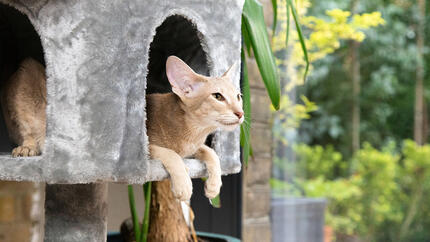


Compared to dogs, cats are generally far more independent. While they enjoy your company, they don’t need it in the same way that canines do, and interactions with even the most demanding and affectionate cat will be very much on their terms. This makes them ideally suited to those who prefer a lower maintenance, less needy furry friend, or those who don’t have the time or the inclination to have to walk in the rain every day!
These personality traits can have a flip side, though, as this means cats are generally solitary animals and are far less social so often take longer to feel comfortable and secure around other family members – including the non-human ones. So, if you’re wondering how to introduce a kitten to a dog or another cat, the first thing to know is that you’ll have to be patient, understanding and approach with care.
Introducing a new kitten to your cat
The good news is that adult cats tend to be much more welcoming to kittens than to other adults. If both cats are neutered, better still – although kittens are usually not neutered until around 16 weeks of age.
For the first few days, keep your kitten in one room to give them a chance to settle in.
Before bringing a kitten home, or in the first few days of introducing a kitten to a cat, get your existing cat used to the smell of their new companion. Swap their bedding back and forth over the first week and, if either cat gets angry or distressed around the scent, try to offer calm reassurance by associating the new scent with a positive experience, such as a tasty treat.
Letting the cat settle in the new home
The priority, when introducing a new kitten to your current cat or dog is to help both pets feel relaxed in each other’s company. So, to make the process easier, it’s important that your cat is first comfortable with the new surroundings.
Before starting the introduction process, it’s best to keep both pets apart for a while. Give your new kitten a room of their own where they can settle in for a few days with their own food, warm bed, water bowls, and a litter tray. This should be a room where you can keep them quiet company too.
This is a good time to introduce them to a mesh or wire crate too. Have the door open, have some soft bedding in there, and you can even put their food or some kitten toys in there. This is going to make introducing your kitten to your existing cat far easier.
You can try using one or two synthetic pheromone spray and plug-in diffusers around the house, especially in rooms where your cats are living, as these can help them relax and accept the presence of other felines. If you are introducing your kitten to a dog, remember that dog and cat pheromones are different so use cat ones where your kitten is spending most of the their time and dog ones where your dog is.
Getting the introduction process started
Introducing a new kitten to an adult cat
If you're bringing a second cat home where an adult cat already lives, follow these tips to make introductions safer and more successful for you all:
- While the new cat is settling in their room, start to introduce their scent to your existing cat. Let your cat smell your hands and clothing. Give them the time and space to investigate the new scent while keeping their routine and your interactions the same as usual.
- If you have the space and if you are able, when both cats appear comfortable with each other’s scent you can allow them to explore each other's territory, but still keep them apart.
- When you’re confident that they’re both relaxed in each other’s areas, you can start introducing your cat to the new kitten.
- If you can do this through a glass door (such as a patio door or internal glass door) this is ideal as they can both see each other and are free to approach and retreat as they need to. Don’t force this in any way – always make interactions both cats’ choice.
- If this goes well, you can progress to mesh or barrier introductions.
- Keep one cat secure in a mesh pen or carrying basket and allow the other free rein to explore and sniff through the mesh for a few minutes. Once again, keep these interactions short and not forced. The ‘free’ cat must always have the ability to leave at any time. If the existing cat chooses to totally ignore the new arrival, that’s fine! The mesh or barrier will keep both cats safe, prevent any chasing or any possible injuries. Your aim is for them both to be comfortable in each other’s presence.
- Your aim is always to end these interactions while everyone is calm.
- If your adult cat is happy in a basket, you can alternate who is secure and who is free.
- You can use baby gates as a barrier – but remember that cats can jump and that kittens can squeeze through tiny spaces so you may need to adapt them accordingly using mesh.
- Don’t force the cats to be close to each other. Give them plenty of room and places to escape to if they just want a bit of peace and quiet.
- After plenty of successful barrier introductions, you can progress to face to face meetings. These should be low-key with no pressure to interact. Make sure both can retreat and leave if they need to – and having places your adult cat can use to jump onto to get out of the way but still watch your new kitten can be really helpful.
- Make the experience a positive one for both using toys or treats.
- Most importantly, do not rush any stage and always supervise these early interactions.
- By following these steps, you should be able to get your cats comfortable with each other and living together in harmony.
Be realistic. Unlike dogs who are generally very social, there is no way of knowing how long it will take for your existing cat to get used to having a kitten in the house. Some will accept the new arrival quickly and they will become firm friends interacting freely and affectionately with each other. Others will take longer and may largely ignore each other. Some may decide that they don’t want another cat in the house at all or will need to be allowed to lead separate lives.
Preventing bullying or conflict between cats
Provide separate resources in different areas. This includes feeding areas, water bowls, litter trays, toys, beds cat trees etc. Have one more of each than you have cat. This will reduce competition and foster more harmonious relations.
Provide plenty of resting/supervising areas at different heights.
If your cats go outside, try and provide two different entrances/exits so one doesn’t ‘block’ the other. If this is impossible, provide indoor litter trays as well as outdoor access.
Make sure you give both cats equal attention – and the kind of attention they value (whether that is physical affection, games and play, grooming, interactive toys etc).
By doing this, you can be more likely to ensure feline harmony.
Introducing an adult cat to an existing cat
The procedure is exactly the same as above but be sure to take each step slowly and be quick to intervene and go back a step if there are signs of conflict. It is important to ensure both cats feel ‘safe’ at each step.
How to introduce a kitten to a dog?
Introducing a potentially nervous kitten to an excitable dog (or just a dog who has never lived with a cat before) must be handled carefully for the welfare of both pets. If you’re wondering how to introduce a cat to a dog, the most important thing to keep in mind is safety – the dog’s as well as the cat’s.
An over-excited dog or puppy can easily harm a kitten and a frightened cat can do a lot of damage with their claws. By taking things slowly and concentrate on both pets’ needs and you can foster a lasting relationship based on mutual respect – and hopefully even a friendship.
Even if your existing dog is used to cats – and is unlikely to raise so much as an eyebrow at a new cat or kitten - it’s still important to take great care with introductions. Follow our helpful tips for a hassle-free introduction.
If your kitten is coming from a breeder or a home environment, bring something home with you that smells of your new kitten. This will give your dog a scent introduction to the impending new arrival.
As always when you bring home a new kitten, keep them to one room in the house so they can get used to their new home – and its new smells, sights, noises and people. Your dog will already be able to smell them and will know they are there – and your kitten will also be able to hear and smell your dog.
Give your kitten something that smells of your dog too – such as a small bit of vet bed.
Once your kitten is settled in, you can do some barrier introductions. This can be done by using a mesh barrier between your kitten’s room and your dog – or you could have your dog in a playpen or crate. The latter isn’t so good as the dog can’t retreat if they feel they need to.
Distract your dog with treats and even doing some training exercises for rewards. You want to link the kitten (and ignoring the kitten) with positive things.
Try and ignore the kitten yourself (as long as it is safe). If you seem really interested in the kitten, your dog is likely to be too!
Once you move on to face to face meetings, have your dog on the lead for safety. This will also prevent your dog form chasing the kitten if they run. This is scary for the kitten – and you do not want your dog to learn that chasing the cat is fun!
Once your dog is happy to ignore the kitten, you can progress to a long line and eventually off the lead.
Supervise all early introductions.
Always make sure the kitten has somewhere safe to retreat to out of the way of the dog. This could be through a baby gate that the dog can’t get through and once they are older, a high surface they can jump on is ideal too.
Follow the same procedure if you are introducing an adult cat to your dog.
If you have more than one dog, always introduce your cat to one dog at a time.
Learn about feline body language – so you always know if your cat is feeling scared, worried, anxious – or predatory!
Establish individual cat/dog areas
Make sure your dog doesn’t have access to your cat's litter box because, as scavengers, dogs are likely to consume the contents – not nice, but true! Also always separate cats and dogs at mealtimes so both can eat in comfort – you may wish to try feeding in separate rooms or feeding your cat on an elevated surface that your dog cannot reach.
Finally, make sure your cat gets plenty of opportunity to chase, stalk, and pounce on moving toys. Your dog is unlikely to want your cat to use their tail as a plaything!
The most important consideration when introducing a new cat to a dog is safety. If you have any concerns about introducing your kitten or new cat to your existing pets, talk to an accredited behaviourist for help and advice.
While cats and dogs can be great friends, or live quite happily together even if they’re not, some pets should be kept away from cats. Small furry animals, like rabbits, guinea pigs, mice, rats, gerbils and chinchillas, as well as reptiles, must be protected at all times from cats.
Now that you know how to introduce a kitten to a dog or another cat, all you have to do is be patient and take your time.












